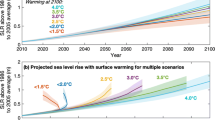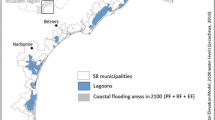Abstract
This paper applies the DIVA model to assess the risk of and adaptation to sea-level rise for the European Union in the 21st century under the A2 and B1 scenarios of the Intergovernmental Panel on Climate Change. For each scenario, impacts are estimated without and with adaptation in the form of increasing dike heights and nourishing beaches. Before 2050, the level of impacts is primarily determined by socio-economic development. In 2100 and assuming no adaptation, 780 × 103 people/year are estimated to be affected by coastal flooding under A2 and 200 × 103 people/year under B1. The total monetary damage caused by flooding, salinity intrusion, land erosion and migration is projected to be about US$ 17 × 109 under both scenarios in 2100; damage costs relative to GDP are highest for the Netherlands (0.3% of GDP under A2). Adaptation reduces the number of people flooded by factors of 110 to 288 and total damage costs by factors of 7 to 9. In 2100 adaptation costs are projected to be US$ 3.5 × 109 under A2 and 2.6 × 109 under B1; adaptation costs relative to GDP are highest for Estonia (0.16% under A2) and Ireland (0.05% under A2). These results suggest that adaptation measures to sea-level rise are beneficial and affordable, and will be widely applied throughout the European Union.





Similar content being viewed by others
References
Alcamo J, Moreno J, Nováky B, Bindi M, Corobov R, Devoy R, Giannakopoulos C, Martin E, Olesen J, Shvidenko A (2007) Europe. In: Parry M, Canziani O, Palutikof J, van der Linden P, Hanson C (eds) Climate change 2007: impacts, adaptation and vulnerability. contribution of Working Group II to the Fourth Assessment Report of the Intergovernmental Panel on Climate Change. Cambridge University Press, Cambridge, pp 541–580
CIESIN and CIAT (2004) Gridded Population of the World (GPW), Version 3. Center for International Earth Science Information Network, Columbia University and Centro Internacional de Agricultura Tropical, Palisades. CIESIN, Columbia University, NY
de la Vega-Leinert A, Nicholls RJ, Tol RSJ (eds.) (2000) Proceedings of the SURVAS Expert Workshop on European Vulnerability and Adaptation to Accelerated Sea-Level Rise, Hamburg, Germany, 19–21 June, Flood Hazard Research Centre, Middlesex University, Enfield, UK
DINAS-COAST Consortium (2006) DIVA 1.5.5. Potsdam Institute for Climate Impact Research, Potsdam, Germany, CD-ROM
European Commission (2007) Green Paper from the Commission to the Council, the European Parliament, the European Economic and Social Committee and the Committee of the Regions. Adapting to climate change in Europe options for EU action. Technical report, European Commission
European Commission (2009) White Paper from the Commission to the Council, the European Parliament, the European Economic and Social Committee and the Committee of the Regions. Adapting to climate change: Towards a European framework for action. Technical report, European Commission
Grinsted A, Moore JC, Jevrejeva S (2009) Reconstructing sea level from paleo and projected temperatures 200 to 2100 AD. Climate Dyn. doi:10.1007/s00382-008-0507-2
Haigh I, Nicholls R, Wells N (2010) Assessing changes in extreme sea levels: Application to the English Channel, 1900–2006. Continental Shelf Research, accepted
Hamilton JM, Maddison DJ, Tol RSJ (2005a) Climate change and international tourism: a simulation study. Glob Environ Change 15(3):253–266
Hamilton JM, Maddison DJ, Tol RSJ (2005b) The effects of climate change on international tourism. Clim Res 29:255–268
Hinkel J (2005) DIVA: an iterative method for building modular integrated models. Advances in Geosciences 4:45–50
Hinkel J, Klein RJT (2009) The DINAS-COAST project: developing a tool for the dynamic and interactive assessment of coastal vulnerability. Glob Environ Change 19(3):384–395
Hoozemans FJ, Marchand M, Pennekamp H (1993) Sea level rise: a global vulnerability assessment: Vulnerability assessments for population, coastal wetlands and rice production on a global scale. Delft Hydraulics and Rijkswaterstaat, Delft and The Hague, The Netherlands, revised edition
Hastings DA, Dunbar PK, Elphingstone GM, Bootz M, Murakami H, Maruyama H, Masaharu H, Holland P, Payne J, Bryant NA, Logan TL, Muller JP, Schreier G, MacDonald JS (eds) (1999) The Global Land One-kilometer Base Elevation (GLOBE) Digital Elevation Model, Version 1.0. National Oceanic and Atmospheric Administration, National Geophysical Data Center, 325 Broadway, Boulder, Colorado 80305-3328, U.S.A. Digital data base on the World Wide Web (URL: http://www.ngdc.noaa.gov/mgg/topo/globe.html) and CD-ROMs
IMAGE Team (2002) The IMAGE 2.2 implementation of the SRES scenarios. RIVM Rapport 481508018, CD-ROM, RIVM, Bilthoven, the Netherlands
IPCC (2007a) Summary for Policymakers. In: Solomon S, Qin D, Manning M, Chen Z, Marquis M, Tignor KAM, Miller H (eds) Climate change 2007: the physical science basis. Contribution of Working Group I to the Fourth Assessment Report of the Intergovernmental Panel on Climate Change. Cambridge University Press, Cambridge, p 996
IPCC (2007b). Climate Change 2007: Synthesis Report. Contribution of Working Groups I, II and III to the Fourth Assessment Report of the Intergovernmental Panel on Climate Change [Core Writing Team, Pachauri, R.K and Reisinger, A. (eds.)]. IPCC, Geneva, Switzerland, 104 pp
Klein RJT, Nicholls RJ, Mimura N (1999) Coastal adaptation to climate change: can the IPCC technical guidelines be applied? Mitig Adapt Strateg Glob Change 4:51–64
Klein R, Nicholls R, Ragoonaden S, Capobianco M, Aston J, Buckley E (2001) Technological options for adaptation to climate change in coastal zones. J Coast Res 17(3):531–543
Kont A, Jaagus J, Aunap R, Ratas U, Rivis R (2008) Implications of sea-level rise for Estonia. J Coast Res 24(2):423–431
Lichter M, Vafeidis AT, Nicholls RJ, Kaiser G (2010) Exploring data-related uncertainties in analyses of land area and population in the Low Elevation Coastal Zone (LECZ). Under review
Lowe JA, Howard TP, Pardaens A, Tinker J, Holt J, Wakelin S, Milne G, Leake J, Wolf J, Horsburgh K, Reeder T, Jenkins G, Ridley J, Dye S, Bradley S (2009) UK climate projections science report: marine and coastal projections. Met Office Hadley Centre, Exeter
Maaten R (2006) River Effect. DINAS-COAST Consortium, 2006. Diva 1.5.5. Potsdam Institute for Climate Impact Research, Potsdam, Germany, CD-ROM
McFadden L, Nicholls RJ, Vafeidis AT, Tol RSJ (2007) A methodology for modeling coastal space for global assessment. J Coast Res 23(4):911–920
Nakicenovic N, Swart R (eds) (2000) Emissions scenarios. Special Report of Working Group III of the Intergovernmental Panel on Climate Change. Cambridge University Press, Cambridge
Nicholls RJ (2000) Coastal Zones. In: Parry ML (ed) Assessment of the potential effects of climate change in Europe. Jackson Environment Institute, University of East Anglia, pp 243–259
Nicholls RJ (2002) Rising sea levels: potential impacts and responses. In: Hester R, Harrison RM (eds) Global environmental change. issues in environmental science and technology, vol 17. Royal Society of Chemistry, Cambridge, pp 83–107
Nicholls RJ (2004) Coastal flooding and wetland loss in the 21st century: changes under the SRES climate and socio-economic scenarios. Glob Environ Change 14(1):69–86
Nicholls RJ, Hoozemans F, Marchand M (1999) Increasing flood risk and wetland losses due to global sea-level rise: regional and global analyses. Glob Environ Change 9:69–87
Nicholls RJ, Klein RJT (2005) Climate change and coastal management on Europe’s coast. Managing European Coasts: Past, Present and Future, J. E. Vermaat et al, Eds., Springer, Environmental Science Monograph Series, pp 199–225
Nicholls R, Wong P, Burkett V, Codignotto J, Hay J, McLean R, Ragoonaden S, Woodroffe C (2007) Coastal systems and low-lying areas. In: Parry M, Canziani O, Palutikof J, van der Linden P, Hanson C (eds) Climate change 2007: impacts, adaptation and vulnerability. Contribution of Working Group II to the Fourth Assessment Report of the Intergovernmental Panel on Climate Change. Cambridge University Press, Cambridge, pp 315–356
Nicholls RJ, de la Vega-Leinert AC (Guest Editors) (2008) Implications of sea-level rise for Europe’s coasts. Journal of Coastal Research 24 (2), 285–442
Peltier W (2000) Global glacial isostatic adjustment and modern instrumental records of relative sea level history. Sea Level Rise: History and Consequences 75, 65–95
Petoukhov V, Ganopolski A, Brovkin V, Claussen M, Eliseev A, Kubatzki C, Rahmstorf S (2000) CLIMBER-2: a climate system model of intermediate complexity. Part I: model description and performance for present climate. Climate Dyn 16(1):1–17
Rabus B, Eineder M, Roth A, Bamler R (2003) The shuttle radar topography missiona new class of digital elevation models acquired by spaceborne radar. ISPRS J Photogramm Remote Sens 57(4):241–262
Richards J, Nicholls RJ (2009) Impacts of climate change in coastal systems in Europe. PESETA-Coastal Systems study. JRC Scientific and Technical Reports EUR 24130 EN, 124 pp. http://ipts.jrc.ec.europa.eu/publications/pub.cfm?id=2979
Rochelle-Newall E, Klein R, Nicholls R, Barrett K, Behrendt H, Bresser T, Cieslak A, de Bruin E, Edwards T, Herman P et al. (2005) Group report: global change and the European coast–climate change and economic development. Managing European coasts: past, present and future, pp 239–254
Rodriguez E, Morris CS, Belz JE, Chapin EC, Martin JM, Daffer W, Hensley S (2005) An assessment of the SRTM topographic products. Technical Report JPL D-31639, Jet Propulsion Laboratory, Pasadena
Rotmans J, Hulme M, Downing TE (1994) Climate change implications for Europe. Glob Environ Change 4(2):97–124
Schijf J, Schnfeld J (1953) Theoretical considerations on the motion of salt and fresh water. Proceedings of the Minnesota International Hydraulics Convention. Joint meeting of the International Association for Hydraulic Research and the Hydraulics Division of the American Society of Civil Engineers, Minnesota, 1–4 September 1953, St. Anthony Falls Hydraulic Laboratory, pp 321–333
Stive MJ, Capobianco M, Wang Z, Ruol P, Buijsman M (1998) Morphodynamics of a tidal lagoon and the adjacent coast. In: Dronkers J, Scheffers M (eds) Physics of Estuaries and coastal seas. Balkema, Rotterdam, pp 397–407
Swart R, Mitchell J, Morita T, Raper S (2002) Stabilisation scenarios for climate impact assessment. Glob Environ Change 12(3):155–165
Tol RSJ (2006) The DIVA model: socio-economic scenarios, impacts and adaptation and world heritage. DINAS-COAST Consortium, 2006. Diva 1.5.5. Potsdam Institute for Climate Impact Research, Potsdam, Germany, CD-ROM
Tol RSJ, Yohe GW (2007) The weakest link hypothesis for adaptive capacity: an empirical test. Glob Environ Change 17:218–227
Tol RSJ, Klein RJT, Nicholls RJ (2008) Towards successful adaptation to sea-level rise along Europe’s coasts. J Coast Res 24(2):432–450
Tol RSJ et al. (2010) Flooding and sea level rise: an application of DIVA, forthcoming
Vafeidis AT, Boot G, Cox J, Maatens R, Mcfadden L, Nicholls RJ, Tol RSJ (2006) The DIVA Database Documentation. Technical report
Vafeidis AT, Nicholls RJ, McFadden L, Tol RSJ, Hinkel J, Spencer T, Grashoff PS, Boot G, Klein R (2008) A new global coastal database for impact and vulnerability analysis to sea-level rise. J Coast Res 24(4):917–924
van Goor M, Zitman T, Wang Z, Stive M (2003) Impact of sea-level rise on the morphological equilibrium state of tidal inlets. Mar Geol 202:211–227
van Koningsveld M, Mulder JPM, Stive MJF, van der Valk L, van der Weck AW (2008) Living with sea-level rise and climate change: a case study of the Netherlands. J Coast Res 24(2):367–379
Vermeer M, Rahmstorf S (2009) Global sea level linked to global temperature. PNAS 106(51):21527–21532
von Storch H, Woth K (2008) Storm surges: perspectives and options. Sustainability Science 3(1)
Woodworth PL, Blackman DL (2004) Evidence for systematic changes in extreme high waters since the mid-1970s. J Climate 17(6):1190–1197
Zhang K, Douglas BC, Leatherman SP (2000) Twentieth century storm activity along the U.S. East Coast. J Climate 13:1748–1761
Zhang K, Douglas B, Leatherman S (2004) Global warming and coastal erosion. Clim Change 64:41–58
Acknowledgements
This study was partly financed by the Environmental Protection Agency Germany (UBA Dessau) and the European Environment Agency (EEA; contract number Z6-002595707). The first version of the DIVA model was developed within the project DINAS-COAST, which was funded by the European Commission’s Directorate-General Research (contract number EVK2-2000-22024). We thank Torsten Grothman, Stéphane Isoard, André Jol, Zbyszek Kundzewicz, Andrus Meiner, Manuel Winograd, Reinhard Mechler and two anonymous reviewers for their helpful comments on earlier versions of this paper and Lars Exner for his technical support in preparing the figures.
Author information
Authors and Affiliations
Corresponding author
Rights and permissions
About this article
Cite this article
Hinkel, J., Nicholls, R.J., Vafeidis, A.T. et al. Assessing risk of and adaptation to sea-level rise in the European Union: an application of DIVA. Mitig Adapt Strateg Glob Change 15, 703–719 (2010). https://doi.org/10.1007/s11027-010-9237-y
Received:
Accepted:
Published:
Issue Date:
DOI: https://doi.org/10.1007/s11027-010-9237-y




